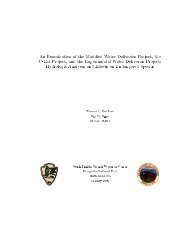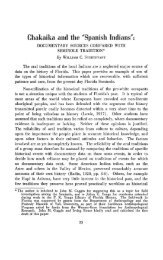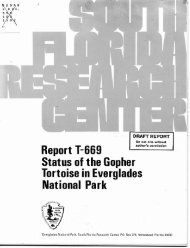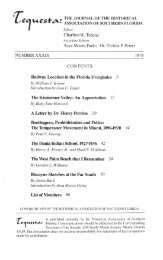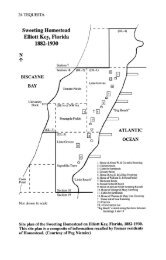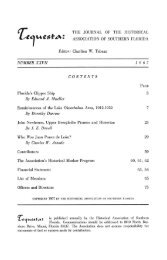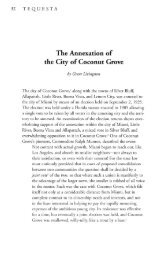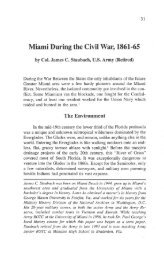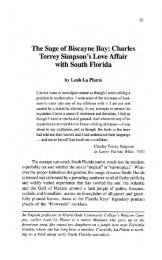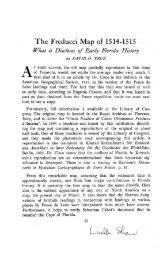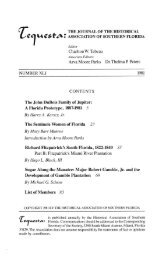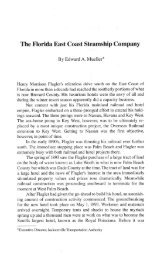Tequesta : Number - 50/1990 - FIU Digital Collections
Tequesta : Number - 50/1990 - FIU Digital Collections
Tequesta : Number - 50/1990 - FIU Digital Collections
Create successful ePaper yourself
Turn your PDF publications into a flip-book with our unique Google optimized e-Paper software.
16 TEQUESTA<br />
to bring in another machine. Wesley taught us the art of removing<br />
palmettos. The saw palmetto has a reclining trunk that runs along the<br />
top of the earth, anchoring itself every inch or so with fibrous roots, each<br />
one as strong as a manila rope of the same size.<br />
"You cut off the roots like you would cut off the legs of a centipede,"<br />
said John. And he would chop along one side of a palmetto trunk with<br />
his grubbing hoe, then turn around and chop along the other side. When<br />
he got through he would lift the rootless trunk from the earth. "See?"<br />
he added, demonstrating how easy it was.<br />
Most of our planting of broadleaved trees, palms and shrubs was<br />
restricted to the property borders when we sought to create a screen<br />
between us, the streets and the rapid growing housing developments. In<br />
time our acreage began to take on a park-like atmosphere. And then is<br />
when the problems began. As new people moved into the neighborhood,<br />
our woods proved to be a charm that attracted both children and<br />
grownups - to play, to picnic, to ride horses, to search for firewood, to<br />
plunk at songbirds with BB guns or .22-caliber rifles, and even to cut the<br />
small pines for Christmas trees. Whenever we said anything, the reply<br />
was nearly always the same: "I didn't know anybody owned this<br />
property." I really think they failed to notice that the property, although<br />
partly wild, was also cultivated, with a screen of plants growing along<br />
the borders and lawn grass in the vistas between the clumps of palmettos.<br />
Up From the Sea<br />
Viewing the pine woods from our house, no one could have suspected<br />
that almost solid limestone lay just beneath the surface of the<br />
grass-covered vistas. It was a distinct formation - oolite - which<br />
geologists have given the local name of Miami Limestone. Only the<br />
swale, where the mixture of marly soil and sand was two to three feet<br />
deep, could you turn the soil to make a garden or dig a hole with a shovel.<br />
On the slopes rising gently from the swale, where the pines and<br />
palmettos grew, the surface was covered by a thin layer of sand and<br />
brittle weathered limerock. This layer could be removed with the aid<br />
of a grubbing hoe, but whenever we tried to dig a hole in the white<br />
limestone beneath, deep enough to set out even a small plant, it yielded<br />
only to a railroad pick and a back tempered by hard work. When we first<br />
moved to Montgomery Drive, I used dynamite to blow planting holes,<br />
usually half a stick to make a hole large enough for a small plant. In the



